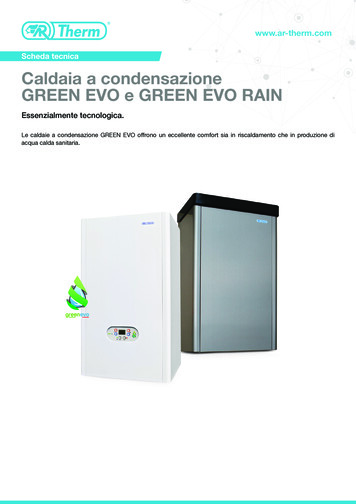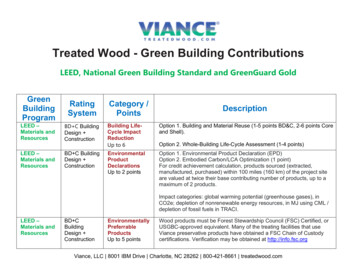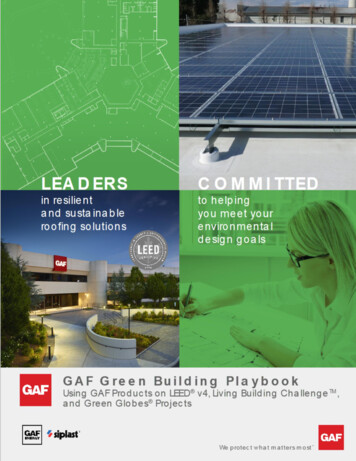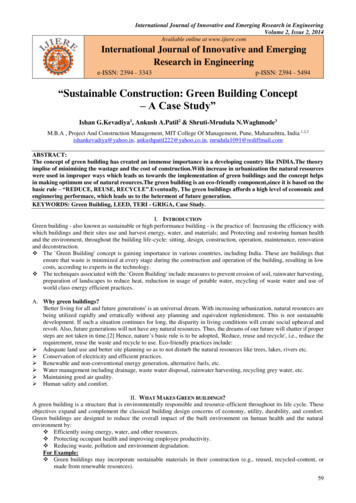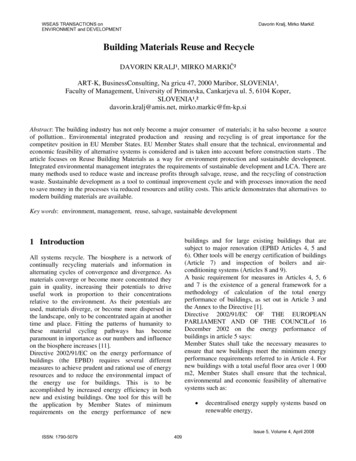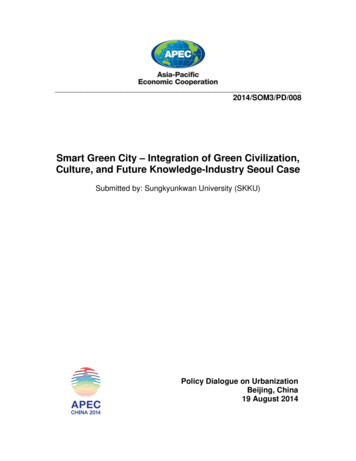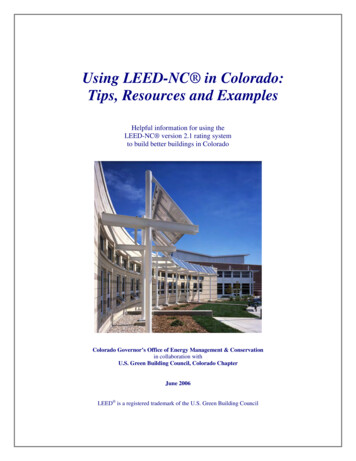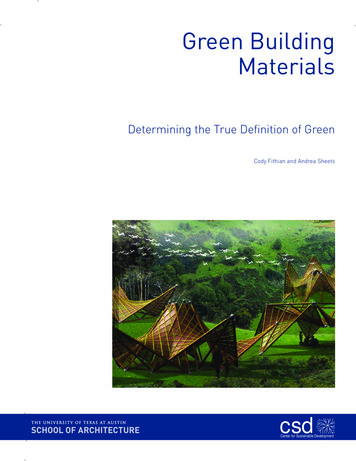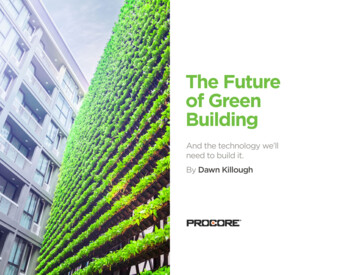
Transcription
The Futureof GreenBuildingAnd the technology we’llneed to build it.By Dawn Killough
THE FUTURE OF GREEN BUILDING2Table of ContentsI.Air-Cleaning Materials4II.Microgrids6III. Net-Zero Buildings8IV. Smart Glass10V. Electricity-Generating Glass12VI. The Future of Green Building is as Bright as its Past14SHARE
THE FUTURE OF GREEN BUILDING3We know where green building has been,but where will it take us?The future of green building technology is full of opportunities forus to undo some of the damage we have done to the planet and theenvironment. The green building materials market is expected to bemore than 254 billion in 2020, according to Navigant Research.Timothy C. Mack of AAI Foresight predicts the future of greenbuilding materials will hold air cleaning materials, micro-grids, netzero buildings, and smart glass. 254 billion in 2020SHARE
I. Air-Cleaning MaterialsEase Cleaning WoesPost-ConstructionAir cleaning materials, such as paint and concrete, use technology andnatural elements to help them take pollutants from the air and breakthem down into harmless substances. There are two technologies thatcan achieve this goal: nanoscale titanium dioxide and TX Active.
THE FUTURE OF GREEN BUILDING5Products with nanoscale titanium dioxide included inand remove pollutants from the air. TX Active, liketheir ingredients use UV light and water molecules totitanium dioxide, is activated by UV light, and workshelp break down impurities as they fall on surfaces.to breakdown dirt, algae, mold, mildew, and otherTitanium dioxide has been successfully addedpollutants and remove them easily when sprayed withto interior and exterior paints, concrete, pavers,water. The product manufacturer recommends thatroof panels, and other materials. These productsTX Active cement be used as a final finish layer, withessentially “eat” the pollution in the air and break itthe rest of the structure being composed of normaldown into non harmful byproducts that are washedconcrete. This will keep costs down, as TX Activeaway by rain or other moisture sources.cement is more expensive than regular concrete. ItExterior products, such as concrete or pavers,can add TX Active to the mix to ease cleaningalso comes in a stucco product, which can be goodfor shedding dirt and grime over time.SHARE
II. Microgrids CouldMean Big Business forthe Next Three YearsMicrogrids are small electrical grid systems, usually establishedbetween several connected buildings that produce, store, anddistribute energy amongst themselves, exchanging power as needed.They are found in universities, military bases, and other governmentcompounds. They can be self-sufficient, disconnecting completelyfrom the public electrical grid.
THE FUTURE OF GREEN BUILDING7The two major pieces that a microgrid needs topower electronics, control systems, and software toolsoperate autonomously are the ability to generatefor storage optimization and sizing.power and store power. As solar and wind powertechnology becomes more efficient and lessThe Office of Electricity Delivery and Energyexpensive, communities or campuses will be ableReliability (OE) has established goals for the use ofto develop their own power generation centersmicrogrids in the coming years. The goals are “tousing these resources. Power storage technologydevelop commercial-scale microgrid systems (capacityis always improving and becoming more efficient.of less than 10 MW) capable of reducing outageThe US Department of Energy is actively workingtime of required loads by more than 98% at a costto improve the technology in this area. Options forcomparable to non integrated baseline solutions whileenergy storage include batteries (both conventionalreducing emissions by more than 20% and improvingand advanced), electrochemical capacitors, flywheels,system energy efficiencies by more than 20% by 2020.”Reduce outage timeReduce emissions byImprove energyof required loads bymore than 20%efficiencies by moremore than 98%than 20%SHARE
III. Net-Zero Buildingsat a Net-Zero(Additional) CostAlong with microgrids, the future holds more net zero buildings. Netzero buildings generate as much energy as they use over the course ofa year. The technology to build these buildings and their systems existsnow, but the problem is the cost. Many projects find that net zero is notattainable within their budget.
THE FUTURE OF GREEN BUILDING9The key to net zero energy use is using passive systems to heat and coolspaces. Passive design includes using building mass, operable windows,and the chimney-effect to naturally heat and cool building spaces. Largeareas of stone, concrete, or water absorb and store heat during the day,then release it during the cooler evening hours.Opening windows at a lower level and skylights or clerestory windows atthe top of a building allow for natural ventilation through drafts, withoutthe need for fans. These drafts and the use of thermal mass allowsbuildings in some climates to be naturally ventilated, without the need foradditional HVAC equipment, thus saving energy and money.SHARE
IV. Smart Glass MeansUsers can StopSquintingSmart glass is glass that can tint itself to keep the interior of abuilding cool. The tinting shades the interior and prevents heat fromtransferring. There are two types of smart glass: electrochromicand thermochromic.
THE FUTURE OF GREEN BUILDING11Electrochromic glass responds to electricity by changing its color. A filmis printed onto the glass that responds to electricity by changing fromopaque to colored, usually blue. With this glass, an operator must createthe electrical charge that starts the change in color. The transition flowsfrom the outside to the inside of the pane of glass. Once the glass reachesthe required tinting, no further electrical stimulation is required to keepit there.Thermochromic glass is similar, but it responds to changes in temperatureto regulate the amount of tinting needed. This type of smart glass canautomatically provide more tinting when direct sunlight is hitting awindow, cutting down on heat gain and reducing energy costs for coolingthe building. It also automatically becomes more transparent once theglass has cooled down and is out of direct sunlight.SHARE
V. ElectricityGenerating GlassThat Pays for ItselfThe newest glass technology combines smart glass tintingproperties with electrical generation, providing windows thatgenerate electricity for use in the building. If a building has a largefaçade that gets a lot of sunlight, these windows can easily pay forthemselves in a short amount of time.
THE FUTURE OF GREEN BUILDING13A photovoltaic organic film is sprayed or printed onelectricity even in shaded areas and with artificial lightregular glass. The film generates electricity, whichdue to their advanced technologies. Many buildingsis collected in the window frame. Many brands aredon’t have enough unobstructed roof space to mounttouting one year paybacks or less, depending on thea standard PV panel array capable of meeting theiramount of area covered. The film can be placed onelectrical needs. However, if all four sides of a buildingplastics or other materials, as well as glass. Its expectedcan be used to generate power, they may be able tolife span is at least 30 years.completely meet their energy needs, even in climatesor seasons not suited for regular solar power.Though many current brands are reliant on directUV light for power generation, some can generateSHARE
VI. The Future of GreenBuilding is as Brightas its PastThe green technology advances that occur in the next 5-10 yearswill steer the future course of green building. The focus must be onmaking real changes in how we design and construct buildings forthe future. Advances such as air cleaning materials will make ourindoor and outdoor environments healthier.
THE FUTURE OF GREEN BUILDING15Microgrids, net zero buildings, and electricity-generating windows willhelp reduce our dependence on coal and other greenhouse-gas-emittingenergy sources. Smart glass will help make our indoor environments morecomfortable and less expensive to heat and cool, saving energyand money.SHARE
THE FUTURE OF GREEN BUILDING16Author BioDawn Killough is a freelance writer on green building,green technology, and construction. She is the authorof Green Building Design 101, an eBook providing anoverview of green building and design suggestions.Dawn has been writing professionally since 2008, andcurrently is author and site editor at Green BuildingElements, a blog on green building and construction,and a writer for The Jobsite by Procore, a constructionnews blog.Dawn is both a LEED Accredited Professional and aCertified Sustainable Building Advisor. She has workedon several projects seeking LEED certification.She lives with her husband, Steve, and their six cats intheir home in Salem, Oregon. She works as a ContractAdministrator at Rich Duncan Construction. In her sparetime she enjoys reading and country line dancing.For more information, find Dawn on LinkedIn atwww.linkedin.com/in/dawnkilloughSHARE
THE FUTURE OF GREEN BUILDINGPRODUCED BYProcore Technologies, Inc.Procore Technologies, Inc., the world’s most widelyused construction management software, helpsconstruction firms simplify their processes with aneasy-to-use, mobile-enabled platform providingunlimited user licenses and renowned customersupport. Understanding the industry’s uniqueneeds, Procore’s user-centric product developmentensures more efficient project, quality, andfinancial management, helping companies increasecollaboration, build times, and profit.For more information or a free demonstration visitwww.procore.com.Talk with an Expert17Visit The Jobsite Procore’s Hub for Original ContentWatch Procore TV Procore’s Official YouTube ChannelMore Resources Free eBooks & DownloadsIf you have any questions, please give us a call at1.866.477.6267 or email us: sales@procore.comSHARE
of Green Building Design 101, an eBook providing an overview of green building and design suggestions. Dawn has been writing professionally since 2008, and currently is author and site editor at Green Building Elements, a blog on green building and construction, and a writer for The Jobsite by Procore, a construction news blog.



